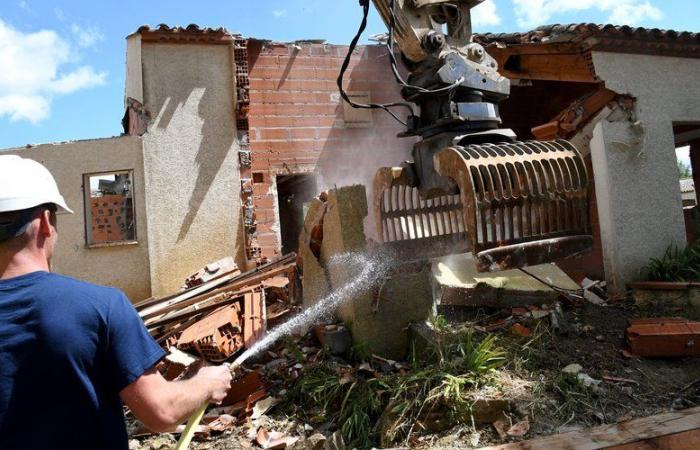If the natural disaster compensation system is based on a system associating public and private, the subject is also closely linked to the Barnier Fund, supplemented by the 12% levied on the Cat Nat surcharge which all policyholders pay. A Fund whose amount caused a stir as part of the examination of the 2025 finance bill (PLF). A Fund which, particularly after the floods of October 2018, demonstrated its usefulness in the department .
On Sunday October 20, on France Info, the president of France Assureurs, a federation bringing together 254 insurance and reinsurance companies, called for an end to “the hold-up on the Barnier fund”. In Florence Lustman's viewfinder, the 2025 finance bill (PLF), and the envelope announced for the major natural risks prevention fund (FPRNM), renamed after the Minister of the Environment at its origin in 1995 , Michel Barnier. Having become Prime Minister almost 30 years later, the same Michel Barnier himself was preparing to significantly reduce the sums allocated to this fund, the revenue of which is based on the 12% taken from the natural disaster surcharges (CatNat) that each holder pays. home or automobile insurance contracts.
Also read:
Faced with the multiplication of natural disasters, can Aude become an “insurance desert”?
A principle started in 2018, first, with a capping of the allocation of these premiums to the fund. Before in 2021 its financing is attached to the general State budget, decorrelating the amounts allocated to the fund from the rate of the surcharge: example in 2023, with a product of the 12% tax levied estimated at €273 million, and a Barnier fund with €205 million. Another proof with the 2025 PLF envisaged, and a forecast envelope of €225 million, identical to that of 2024: far, very far from the €450 million in potential credits that the increase in CatNat surcharges gave rise to on 1is January 2025, increasing from 12 to 20% for property damage insurance contracts (i.e. on average €40 per year per insured instead of €25 according to France Assureurs, Editor's note), and from 6 to 9% for contracts auto.
€225 million, then €300 million, but still far from the expected €450 million
In other words, the Barnier government, in need of revenue, took €225 million from the Barnier fund. On October 25, traveling to the Rhône to see the devastation of the floods of October 17 and 18, the Prime Minister announced the opening of a two-month consultation for October 3e national plan for adaptation to climate change (PNACC), expected since… July 2023. And proposed “to increase the Barnier fund by €75 million for 2025 to reach a commitment of €300 million next year”. More than the €225 million of the PLF, but still less than the expected €450 million. Paradoxical, with regard to two of the five axes of the PNACC: “Protect populations” et “ensure the resilience of territories”.
Also read:
These figures make Aude a territory on the front line for natural disasters… and the demand for insurance
Paradoxical, because the Barnier Fund, if it can be mobilized to finance the purchase by local authorities of homes and business buildings which are seriously threatened by a major natural risk, is also a major tool in terms of prevention: between 1995 and 2022, the sums committed were used 45% for the action plans of local authorities, including flood prevention action programs (PAPI), 32% for individual measures to reduce vulnerability (acquisitions, expropriation , work on existing properties) or even 10% for knowledge, assessment of natural risks and natural risk prevention plans; a commitment quantified by the central reinsurance fund in a report dedicated to the Fund to finance around 700 prevention operations, each year, for an average annual amount of more than €170 million, i.e. a total cumulative amount greater than €2 billion euros.
€11 million from the Barnier Fund after the floods in Aude in 2018
In Aude, it is in particular through the joint union of aquatic environments and rivers (Smmar), and its free Aud'Alabri diagnosis, that individuals and companies can prepare work to reduce the vulnerability of their homes or establishments facing to floods (but not for the shrinkage-swelling of clay or the retreat of the coastline, Editor's note), before requesting financing from the Barnier Fund allowing 80% of the work to be covered for individuals (40% for companies with fewer than 20 employees): in 2023, 99 diagnostics of private homes and 36 diagnostics of public buildings had been carried out, while 171 diagnostics of public buildings and 7 of companies were recorded in 2018 and 2019, or even 146 housing units in 2021.
Also read:
With the Insurability Observatory, detect “phenomena of selection, disengagement or departure of insurers from certain areas”
Enough to materialize the importance of a Fund in a department, which after the dramatic floods of 2018, had benefited from 41% of the sums dedicated nationally by the Fund to acquisitions and expropriations in 2019 and 2020. In June 2024 , in a working document dedicated to the PNACC, the general secretariat for ecological planning provided three examples of “recent crises” to illustrate the costs of CatNat: with for Aude, €220 million in damage to policyholders, and €280 million public aid, including €11 million from the Barnier Fund alone.
For insurance to work, prevention and adaptation must be sufficient
Enough to explain that, on the side of the central reinsurance fund (CCR), the insurer of insurers, the general director Edouard Vieillefond assumes a position aligned with that of the insurers. “Faced with the multiplication of natural disasters and risks
extremes, adaptation and prevention have become central. The increase in the Cat Nat surcharge from 1is January 2025 secures compensation for natural disasters through the Cat Nat scheme in the short term. We also defend an upward revision of the additional premium at a rate between 3 and 5 years and, like the insurers, the maintenance of financing for the Barnier fund in proportion to this additional premium and the evolution of claims, in order to to better anticipate and manage long-term risks. We estimate that the increase in the Cat Nat surcharge levy rate will bring in around 3.75 billion euros in 2025 for the entire scheme. The 12% contribution on the additional premium intended to supplement the financing of prevention, should therefore reach €450 million. We would like part of this amount (€50 million) to be devoted for the first time to the prevention of individual perils, mainly that of the RGA in France and that of cyclones in the overseas territories (where the Barnier fund is used for protection against earthquakes).
For the RGA, Edouard Vieillefond will have to wait. The former Minister of Ecological Transition, Christophe Béchu, had envisaged a budget of €150 million for the “financial support for households” facing the RGA. An amount missing from the 3rd PNACC. The fact remains that the CEO of the CCR ensures that “the Barnier fund is a success. One euro invested in prevention helps avoid three euros of damage, and around eight euros if we take into account the leverage effect of local financing. If we had not had the fund Barnier and the Flood Risk Prevention Plans (PPRI), we would have had an increase in flood claims by a good third between 2000 and 2020, which was not the case. And CCR would very likely have found itself in a situation. situation a little different from that of today, having called on the State as guarantee at least a second time in its history.”
Since 1982, the CCR has only called on the State for help once: the storms of December 1999 led to a drop in the fund's net profit of 44%. The State then contributed €450 million.






